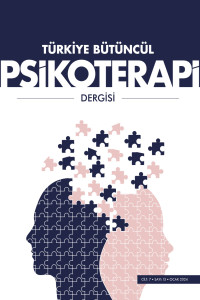An Overview of the Psychotherapy Process of Mr. T., Who Showed the Symptoms of Narcissistic Self-disorder Within the Framework of H. Kohut's Approach to Self-Psychology
Abstract
In the theory of self-psychology developed by Heinz Kohut, the self is accepted as a form of upper organization and states that each individual is born with a core self at birth. In terms of self-psychology theory; It is stated that shortcomings in mirroring, internalization and separation processes in early childhood and adolescence lead to self-pathologies. In other words, the mirroring function of self-objects in contact with the core self of the individual has a vital importance in the formation of the self. Inadequate functioning of self-objects leads to narcissistic personality disorder, which is characterized as halted development.In this context, the case of Mr. T., who was in his thirties, was examined in terms of self-psychology. Expressing his complaints of worthlessness, lifelessness and social incompatibility in his life, Mr. T. said; spent his childhood in a big city far from his relatives, in the rigid environment of a small and lonely family. During his secondary school, high school and university years, he lived in a religious group that had no contact with social life. He said that he put the group teachings at the center of his life. It is seen that the pole of ambitions does not develop due to insufficient mirroring in childhood. In this context; An effort has been made to compensate for the self by developing the 'idealized pole of the parental imago' which is the other pole of the self. It is evaluated that narcissism, created by the identification with the great savior image of the leader in the religious community, causes social adjustment problems, feelings of worthlessness and meaninglessness.
Keywords
References
- Goldberg, A. (Ed.). (1978). The Psychology of the Self: A Casebook. New York, NY: International Universities Press.
- Kohut, H. (1971). The Analysis of the Self. New York, NY: International Universities Press.
- Kohut, H. (1984). How Does Analysis Cure? (A. Goldberg& P. Stepansky, Eds.). Chicago: University of Chicago Press.
- Kohut, H. (1977). The Restoration of the Self. New York, NY: International Universities Press.
- Lessem, P. A. (2005). Self Psychology: An Introduction. Lanham, MD: Rowman & Littlefield Publishers.
- Rowe, C. E. ve Mac Isaac, D. S. (1991). Empathic Attunement: The “Technique” of Psychoanalytic Self Psychology.
- Lanham, MD: Rowman & Little field Publishers.
- Siegel, A. M. (1996). Heinz Kohut and the Psychology of the Self. New York, NY: Routledge.
- Terbaş, Ö. (2004). Kendilik Psikolojisi Kuramına Göre Kendilik Bozukluklar: Bir Olgu Sunumu. Türk Psikiyatri Dergisi, 15 (1), 70-76.
- Türkçapar, M. H. (1995). Kendilik psikolojisi ve Temel Kavramlar. Türk Psikiyatri Dergisi, 6, 125-131.
- Wolf, E. S. (1988). Treatingthe Self: Elements of Clinical Self Psychology. New York, NY: The Guilford Press.
H. Kohut’un Kendilik Psikolojisi Yaklaşımı Çerçevesinde Narsistik Kendilik Bozukluğu Belirtileri Gösteren T. Bey’in Psikoterapi Sürecine Bakış
Abstract
Heinz Kohut tarafından ortaya atılan kendilik psikolojisi kuramında kendilik bir üst örgütlenme biçimi olarak kabul edilmekte ve her bireyin doğarken bir çekirdek kendilik ile dünyaya geldiği belirtilmektedir. Kendilik psikolojisi kuramı açısından erken çocukluk ile ergenlik dönemlerindeki aynalanma, içselleştirme ve ayrılma süreçlerindeki yetersizliklerin kendilik patolojilerine yol açtığı belirtilmektedir. Diğer bir ifadeyle bireyin çekirdek kendiliği ile temas halinde olan kendilik nesnelerinin aynalama işlevi, kendiliğin oluşumu sürecinde hayati bir öneme sahiptir. Kendilik nesnelerinin yetersiz işlev görmesi bireyde gelişimsel duraklama olarak nitelenen narsistik kişilik bozukluğuna yol açmaktadır. Bu çerçevede ele aldığımız otuzlu yaşlardaki T. Bey vakası, kendilik psikolojisi açısından incelenmiştir. Hayatındaki değersizlik duygusu, cansızlık ve sosyal uyumsuzluk şikâyetlerini dile getiren T. Bey; çocukluk dönemini akrabalarından uzakta bir büyükşehirde küçük ve yalnız bir ailenin rijit ortamında geçirmiştir. Ortaokul, lise ve üniversite yıllarını ise sosyal hayatla teması olmayan bir dini grubun içinde yaşamış; grup öğretilerini hayatının merkezine yerleştirdiğini ifade etmiştir. T. Bey’in çocukluk dönemindeki yetersiz aynalanma nedeniyle kendiliğin ihtiraslar kutbunun gelişmediği görülmektedir. Öte yandan kendiliğin diğer kutbu olan idealize edilmiş ebeveyn imagosu kutbunun telafisi yoluna girildiği anlaşılmaktadır. Bu bağlamda dinî cemaat içindeki ruhani liderin ‘büyük kurtarıcı’ imgesiyle yaşanan özdeşim, T. Bey’de narsistik bir kişiliği doğurarak sosyal uyum sorunlarına neden olduğu değerlendirilmiştir. Yetişkinlik döneminde idealize imgeden uzaklaşma deneyiminin ise değersizlik, anlamsızlık, boşluk hislerine neden olduğunu düşündürmektedir.
Keywords
References
- Goldberg, A. (Ed.). (1978). The Psychology of the Self: A Casebook. New York, NY: International Universities Press.
- Kohut, H. (1971). The Analysis of the Self. New York, NY: International Universities Press.
- Kohut, H. (1984). How Does Analysis Cure? (A. Goldberg& P. Stepansky, Eds.). Chicago: University of Chicago Press.
- Kohut, H. (1977). The Restoration of the Self. New York, NY: International Universities Press.
- Lessem, P. A. (2005). Self Psychology: An Introduction. Lanham, MD: Rowman & Littlefield Publishers.
- Rowe, C. E. ve Mac Isaac, D. S. (1991). Empathic Attunement: The “Technique” of Psychoanalytic Self Psychology.
- Lanham, MD: Rowman & Little field Publishers.
- Siegel, A. M. (1996). Heinz Kohut and the Psychology of the Self. New York, NY: Routledge.
- Terbaş, Ö. (2004). Kendilik Psikolojisi Kuramına Göre Kendilik Bozukluklar: Bir Olgu Sunumu. Türk Psikiyatri Dergisi, 15 (1), 70-76.
- Türkçapar, M. H. (1995). Kendilik psikolojisi ve Temel Kavramlar. Türk Psikiyatri Dergisi, 6, 125-131.
- Wolf, E. S. (1988). Treatingthe Self: Elements of Clinical Self Psychology. New York, NY: The Guilford Press.
Details
| Primary Language | Turkish |
|---|---|
| Subjects | Psychotherapy Practise and Research |
| Journal Section | Olgu Sunum Makalesi |
| Authors | |
| Early Pub Date | January 25, 2024 |
| Publication Date | January 30, 2024 |
| Submission Date | November 8, 2023 |
| Acceptance Date | December 22, 2023 |
| Published in Issue | Year 2024 Volume: 7 Issue: 13 |


